Number of church schools and students double in 10 years in Hungary
The number of denominational schools and students in those establishments have radically increased in the past ten years. Church schools are also primary recipients of financial resources from the state.
The figures were revealed in the Statistical Yearbook of Public Education, and from the latest data by the Hungarian Central Statistical Office (KSH). Numbers were compared between the 2010/2011 and 2019/2020 school years.
| 2010/2011 | 2019/2020 | |
| Nursery schools | 141 institutions | 282 institutions |
| 12,400 students | 26,900 students | |
| Elementary schools | 197 institutions | 378 institutions |
| 50,000 students | 111,700 students | |
| Secondary grammar schools | 108 institutions | 172 institutions |
| 37,000 students | 54,900 students |
Number of institutions and students at each level of education.
Source: nepszava.hu
As Népszava outlines, Christian churches have an increasing role in all institutions of primary and secondary education. Tamás Totyik, vice-president of the Hungarian Trade Union of Teachers (Pedagógusok Szakszervezete), says,
There is a school in Hajdú-Bihar County, which is in a terrible condition and was handed to the church so that renovation can start as early as possible.
According to Népszava, the growing role of denominations is more obvious if we take a look at the schools’ member institutions. The table above shows that the number of church-run nursery schools increased to 282 by 2019, but the number of actual locations where the church operated nursery schools is 378 (after an increase from 155 in 2010). What happened here is that these not independent institutions were later incorporated into other, church-run establishments.
The situation is particularly interesting because, at the same time, the presence of public schools has been in decline: the number of elementary schools decreased from 1991 (2010) to 1872 by 2019. In the case of secondary grammar schools, the change is even more dramatic: from 402 there was a decline of 25% to 298 by 2019.
Beyond the school system
As Totyik explains, church schools have a very stable financial situation. Last year, they received four times more money after each student than a public institution did. He says that churches have a growing importance in the process of “society building”. He believes that the government also wants to increase their role in social care.
By the end of the year, the total share of denominations in specialist care and the homes for the retired and disabled will reach 25%. This number is 44–45% for primary care and 60% for child protection services.
The current environment suggests a similar pattern for the near future. Earlier this spring, the government passed a legislation that grants property ownership to the runners of such institutions. And in 2021, the government budget will provide HUF 20 billion more support to church and civil society organisations compared to this year’s budget. In response to questions concerning the amount of support the church is receiving, Zsolt Semjén said last year that it is only fair to give them more money after all those “decades of discrimination”.
Source: nepszava.hu
please make a donation here
Hot news
BREAKING – Shocking testimony: the American woman died in Budapest due to BDSM sex gone wrong?
ORbán cabinet: Chinese BYD investment will put Szeged in Europe’s TOP 30
Scientist with Hungarian origins can treat cancer with viruses? The miraculous recovery of Dr Beáta Halassy
PM Orbán talked about the importance of abolishing the EU’s anti-Russia sanctions
Deadly H5N1 virus spreads in Hungary again
Attention! Wizz Air to impose more fines for oversized baggage






